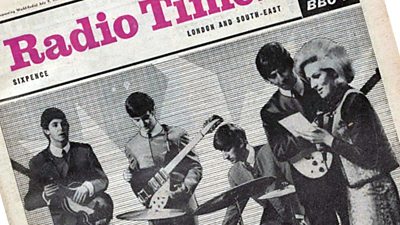Image: Mick Jagger and Charlie Watts of The Rolling Stones talk to DJ Tommy Vance on the Radio 1 show Top Gear on Sunday 3rd December 1967.
30 September 1967 was the culmination of a steady stream of changes to radio output over the previous few years. Major modifications had been made, for example, with the introduction of the Music Programme in 1964 on the Third network, the expansion of the ���˿��� Service’s commitment to news and current affairs, and the use of live studio based programmes such as Top Gear on the Light to cater for the desire of audiences for more pop and rock music.

If the process of change had been piecemeal prior to 1967, from that point forward it was seriously organised. The launch of the new services was almost immediately followed by the setting up of a ���˿��� Working Party whose purpose, as one of its members Gerard Mansell put it, was to “decide about the future of radio, the future of the networks.” It produced a set of principles that were to shape subsequent planning.
The arrival of Charles Hill, the former Conservative MP and wartime “radio doctor”, as the new Chairman of the ���˿��� Board of Governors in 1967 added extra zeal and impetus. As the Director of Radio Frank Gillard recalled, Hill confided in him that “every Chairman’s period in office has to have a hall mark on it … in my case it can’t be television, because television has got colour, it’s got ���˿���2 … So it’s got to be radio, and we’ve got to talk to the public about radio and have a big drive on radio.”
Early in 1968 the management consultants McKinsey & Company were appointed to examine the ���˿���’s use of resources. Alongside this external unit was established an internal Policy Study Group, chaired by Mansell, that examined radio services.
The Policy Study Group’s findings recommitted the ���˿��� to 4 networks, although Radios 1 and 2 would have to share evening programmes due to limited resources. After nearly two years of planning, the ���˿��� was now in a position to announce its vision for the future of radio and in July 1969, on the brink of a new decade, published Broadcasting in the Seventies.
-
The ���˿���'s plan for network radio and non-metropolitan broadcasting, July 1969
Written by the incoming Managing Director of Radio, Ian Trethowan, Broadcasting in the Seventies was intended to facilitate a period of public consultation. “Traditionally,” it noted, “broadcasting has been based on the principle of mixed programming.
On a single channel, the public is offered the whole range: news, documentaries, plays, music, light entertainment, serials, sport – all types of programmes, covering all interests and all ‘brow’ levels. But experience, both in this country and abroad, suggests that many listeners now expect radio to be based more on a different principle – that of the specialised network, offering a continuous stream of one particular type of programme, meeting one particular interest.”
Radio 1 would continue as the pop network and Radio 2 would broadcast ‘light’ or ‘sweet’ music with most ‘spoken word’ programmes transferred to Radio 4. Radio 3 would concentrate wholly on music and the arts, while Radio 4 would become the ���˿���’s speech network. If mixed radio broadcasting was part of the ���˿���’s history, its future was to be ‘generic’.
Choosing to announce its blueprint for the future of radio, including local radio, in such a dramatic and public fashion was a calculated risk – and one that backfired. It was, as Mansell later characterised it, a “big banging type of explosion” that provoked a massive reaction both within Broadcasting House and the general public at large.
Frank Gillard recalled trying to warn Charles Hill “that the radio audience is the most conservative audience in the whole wide world, and you don’t come out with a great big statement that we’re going to make all these changes. What you do is you infiltrate them slowly and gradually and people get used to them, they take them in their stride.” This, however, was no longer an option.
Concerned about the rationalisation of radio along these lines, in an unprecedented move 137 members of ���˿��� staff wrote to The Times in protest. Rather than ushering in a great new age of radio, Broadcasting in the Seventies appeared to many, to be delivering the last rites. For Gerard Mansell, who had been involved in the preparation of the underlying proposals, this was a misleading interpretation of what had been intended.
While deftly navigating the political, programming, financial and administrative challenges facing ���˿��� radio at the time, Broadcasting in the Seventies did not help the ‘crisis of morale’ identified by Mansell, nor did it calm the nerves of listeners. For its author, Ian Trethowan, “it was handled fundamentally wrongly; that the changes were not nearly as dramatic as we made out in public”.
While the four networks did become more clearly identified with particular genres of broadcasting, there remained in each a mixture of different, albeit tailored, programming types. As ���˿��� management had discovered, the appearance of great change can mobilise opinions more than the change itself. Yet, comedy and drama could still be heard on Radio 4, documentary on Radio 2, political debate on Radio 3 and serious news on Radio 1. A pattern of broadcasting emerged that we still recognise today.
It was another two decades before the ���˿��� again attempted a far-reaching overhaul of its radio services. By this time the ���˿��� had added the Radio 5 network (1990) to its operations, which then broadcast an eclectic mix of sport, children’s and educational programmes. Just as in the mid-1960s, a perception of stagnation hung around ���˿��� radio and, echoing the appointment of her predecessor Ian Trethowan, Liz Forgan was brought into the ���˿��� from the world of television in 1993, to run radio.
Interviewed in 1996 as part of the ���˿��� Oral History Collection, she recalls the “radical changes” she was asked to make and reviews the state of radio at the ���˿���.
Despite the continuity of nearly one hundred years of broadcasting, the ���˿��� has always had to invent and reinvent its radio services to suit its audiences and the world around them. The National Programme of the 1920s and 1930s gave way to three different services by 1946 – ���˿���, Light and Third.
The rise of pop and the pirates in the mid-sixties and the need to address the challenge of television resulted in 4 generic networks. Commercial radio in the 1980s and 1990s forced the ���˿��� to reconsider the distinctive tone of public service broadcasting. And, more recently, the proliferation and fragmentation of digital technologies and social media are necessitating a reconceptualization of radio as a medium. This is a story of change that is far from over.

